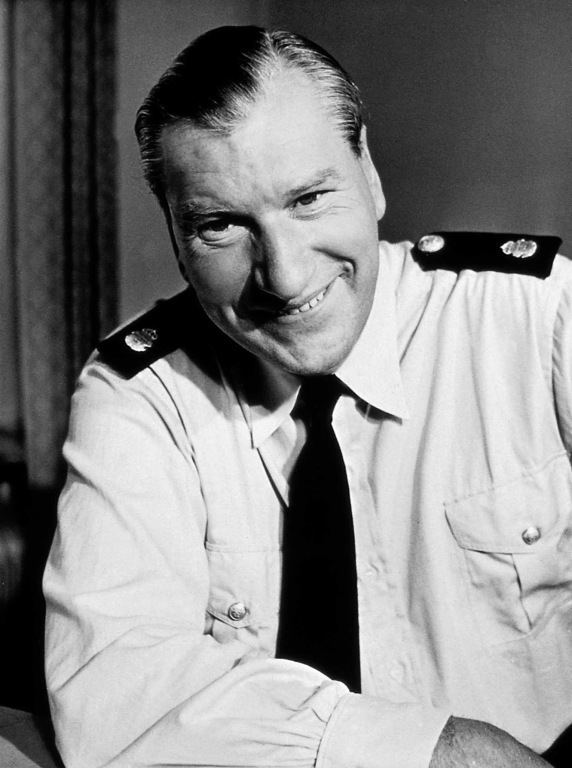Post by teleadm on Oct 2, 2019 11:49:46 GMT
From the mid 1950s to the late 1950's, Jack Arnold (1916-1992) was the director at Universal who created a handful of movies that was equally at home in the Science-Fiction and Horror genres, they could be seen as overlapping into both genres. He also did Westerns and Comedies.
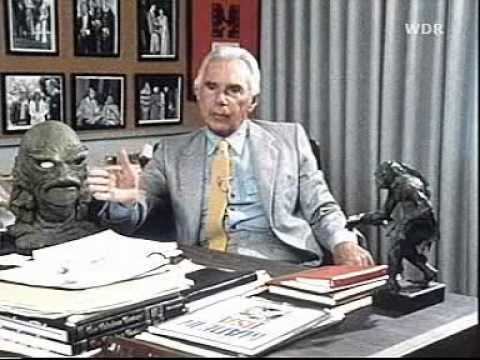
"I love science fiction. As a youngster, I used to buy all the pulp magazines. I loved them. I was very pleased when I was assigned to direct my first SF film because I was still an avid fan. The more I did this type of film the better I liked it, because the studio left me alone. Fortunately, no one at that time at the studio was an expert at directing SF films, so I claimed to be one. I wasn't, of course, but the studio didn't know that. So they never argued with me".
Jack Arnold was born on a kitchen table in New Haven, Connecticut, to Russian immigrant parents.
As a child he read a lot of science fiction, which laid the foundations for his genre films of the 1950s.
He hoped to become a professional actor and in his late teens he enrolled in the American Academy of Dramatic Arts, where his classmates included Hume Cronyn, Betty Field and Garson Kanin.
After graduating he worked as a vaudeville dancer and in 1935 began getting roles in Broadway plays. He was acting in My Sister Eileen when the Japanese attacked Pearl Harbor, and he immediately enlisted as a cadet for pilot training.
While Arnold intended to become a pilot, a shortage of planes meant he was temporarily placed in the Signal Corps, where he took a crash course in cinematography. He then became a cameraman and learned the techniques of filmmaking by assisting Robert Flaherty on various military films.
At the war's end and Arnold's term of service ended, he formed a partnership with an air squadron buddy, Lee Goodman, to form a film production company. Their new company, called Promotional Films Company, made fundraising films for various non-profit organizations.
He also continued acting on stage during this period, in plays including a revival of The Front Page, and played opposite Bela Lugosi and Elaine Stritch in Three Indelicate Ladies.
By 1950, after his documentary films had received more exposure, he was commissioned to produce and direct With These Hands, a documentary about working conditions of the early 20th century. It was nominated for an Academy Award for Best Documentary Feature.
Arnold made his theatrical movie debut with the B picture Girls in the Night 1953. He then did his first foray into the science-fiction genre, the supreme It Came from Outer Space 1953.
Arnold's main collaborator at Universal Studios was producer William Alland.
Arnold began his television career in 1955 with several episodes of Science Fiction Theater. He went on to direct episodes for the long-running television series Perry Mason and Peter Gunn.
Arnold died of arteriosclerosis in Woodland Hills, Los Angeles, California at the age of 75. Later that year, the UCLA Film Archive held a tribute "Jack Arnold: The Incredible Thinking Man" film festival which screened a number of his films. The Archive also produced and screened a bio-documentary about his life, The Incredible Thinking Man.

With These Hands 1950, a film produced by the International Ladies Garment Workers Union, featuring several well-known Broadway actors, recreates the Triangle Fire of 1911 and compares working conditions of the 1910's with the 1950's.
Nominated for Documentary Film Oscar, Arnold's only Oscar nomination.
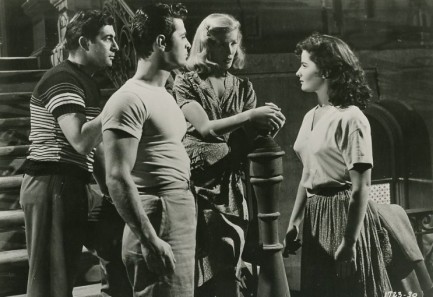
Girls in the Night 1953, Arnold's feature length movie debut as director. It starred Harvey Lembeck, Joyce Holden, Glenda Farrell and Leonard Freeman.
Tagline "LOOKING FOR LOVE IN THE SHADOWS".
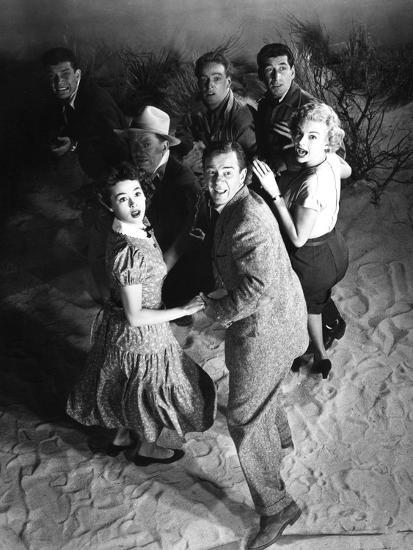
It Came from Outer Space 1953, 3-D Science-Fiction Horror starring Richard Carlson, Barbara Rush, Charles Drake and Joe Swayer.
The first in the 3-D process from Universal-International and the first 3-D film in widescreen.
The script is based on Ray Bradbury's original story treatment and not, as sometimes claimed, a published short story, "The Meteor".
Since its original release, the critical response to the film has become positive. Bill Warren has written that "Arnold's vigorous direction and Bradbury's intriguing ideas meld to produce a genuine classic in its limited field".
Universal digitally restored It Came From Outer Space, and in October 2016 released it on Blu-ray. The film is presented in its original widescreen polarized 3-D and three-track stereophonic sound. Also a non-3-D "flat" version in mono sound.

The Glass Web 1953, a 3-D noir crime drama starring Edward G. Robinson, John Forsythe, Marcia Henderson and Kathleen Hughes, based on Max Simon Ehrlich's 1952 novel "Spin the Glass Web".
Taglines "Blonde, Beautiful...and Born to Be Murdered!" and "The Ultimate in Shocking, Suspenseful 3-D!"

Creature from the Black Lagoon 1954, a black-and-white 3-D monster horror film from Universal-International, produced by William Alland, starring Richard Carlson, Julia Adams, Richard Denning, Antonio Moreno and Whit Bissell. The Creature was played by Ben Chapman on land and by Ricou Browning underwater.
The creature, also known as the Gill-Man, is usually counted among the classic Universal Monsters.
Creature from the Black Lagoon received positive reviews from critics upon its release and is now considered a classic horror film. Leonard Maltin awarded the film three out of a possible four stars, writing, "Archetypal '50s monster movie has been copied so often that some of the edge is gone, but ... is still entertaining, with juicy atmosphere and luminous underwater photography sequences".
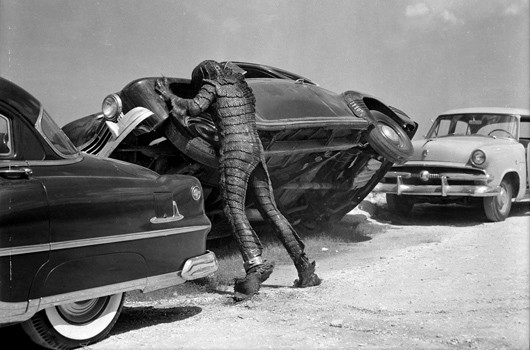
Revenge of the Creature 1955, was the first of two Universal-International sequels to Creature from the Black Lagoon. It was the only 3-D film released in 1955 and the only 3-D sequel to a 3-D film released during "the golden age of 3D". it starred John Agar and Lori Nelson and marked Clint Eastwood's film debut.
The critics upon release was dismissive, though it did well at the box-office.

The Man from Bitter Ridge 1955, and Eastmancolor Western starring Lex Barker, Mara Corday and Stephen McNally, based on a novel by William MacLeod Raine.
A stranger comes to the town of Tomahawk to investigate who's behind a series of stagecoach holdups.
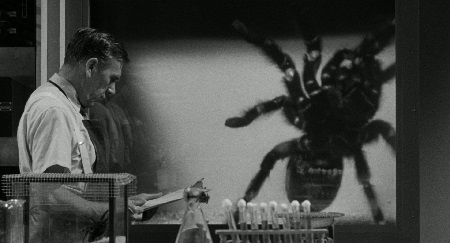
Tarantula 1955, a black-and-white science fiction giant monster film from Universal-International, starring John Agar, Mara Corday, and Leo G. Carroll.
It was the fourth biggest film at the U.S. box-office in December 1955 and earned rentals of $1.1 million on original release.
The contemporary review in Variety indicated "A tarantula as big as a barn puts the horror into this well-made program science-fictioner, and it is quite credibly staged and played, bringing off the far-fetched premise with a maximum of believability".

Red Sundown 1956, a Technicolor Western starring Rory Calhoun, Martha Hyer and Dean Jagger.
A gunfighter takes a deputy sheriff job in a town caught in a feud between a powerful rancher and small farmers.
Tagline "Out of Texas he rode INTO THE FURY OF DURANGO'S WILDEST HOUR!".
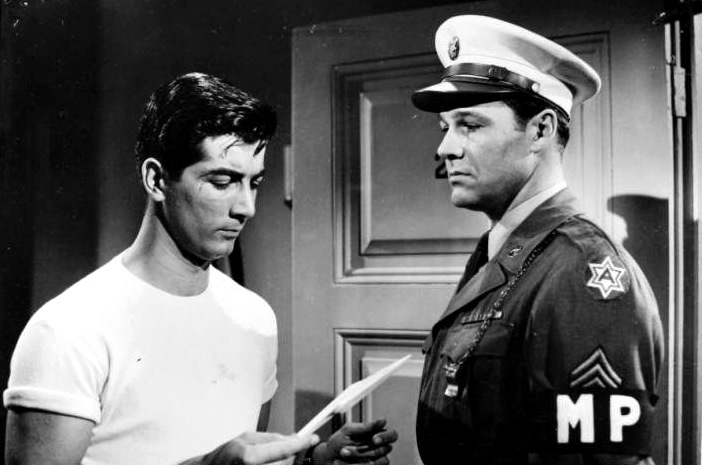
Outside the Law 1956, a noir crime drama starring Ray Danton, Leigh Snowden and Grant Williams.
An ex-con is given the chance to redeem himself, and revenge the murder of an old army buddy, by going undercover in Germany and helping the authorities break up a ring of international counterfeiters who will stop at nothing, including murder, to protect their operation.
Tagline "T-Men Blast Counterfeiting Racket!"

The Incredible Shrinking Man 1957, Science-Fiction based on Richard Matheson's novel "The Shrinking Man" and starring Grant Williams and Randy Stuart.
When Scott Carey begins to shrink because of exposure to a combination of radiation and insecticide, medical science is powerless to help him.
The film grossed $1.43 million in the United States and Canada and was among the highest grossing science fiction films of the 1950s. A sequel, The Fantastic Little Girl, originally penned by Matheson, never went into production.
Ian Nathan of Empire referred to the film as a "classic '50s sci-fi paranoia" and noted how that the everyday objects found at home are "transformed into a terrifying vertiginous world fraught with peril. A confrontation with a ‘giant’ spider, impressively realised, as are all the effects, for its day, has become one of the iconic images of the entire era".

The Tattered Dress 1957, a Cinemascope crime noir drama starring Jeff Chandler, Jeanne Crain, Jack Carson, Gail Russell and Elaine Stewart.
The Los Angeles Times said that Chandler "does the best acting job of his career" in the film.
When top lawyer James Blane gets an acquittal for a man who killed another man for sexually roughing up his trophy wife, the murderous town sheriff frames him for bribing a juror in the case.
It did well at the box-office and Jeff Chandler was a hot property at the time.
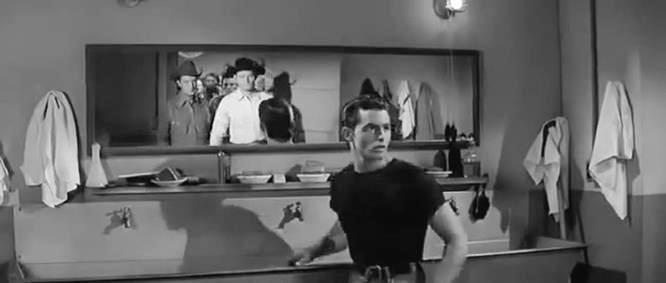
Man in the Shadow 1957, a Cinemascope Crime Western in a contemporary setting, starring Jeff Chandler, Orson Welles, Colleen Miller and Ben Alexander.
Arnold said he had one incident with Orson Welles on Welles' first day of shooting but after that he was "wonderful" to work with and full of good ideas.
In effect, modern cow town Spurline is run by Virgil Renchler, owner of the Golden Empire Ranch. One night, two of Virgil's henchmen go a little too far and beat a "bracero" ranch hand to death. Faced with an obvious cover-up and opposition on every hand, sheriff Ben Sadler is goaded into investigating.

The Lady Takes a Flyer 1958, a romantic comedy-drama starring Lana Turner, Jeff Chandler, Richard Denning and Chuck Connors.
Husband and wife pilots Mike Dandridge and Maggie Colby try to balance their time and priorities between work and family life.
Tagline "He's got his arms around her ... all around the world !!!
"
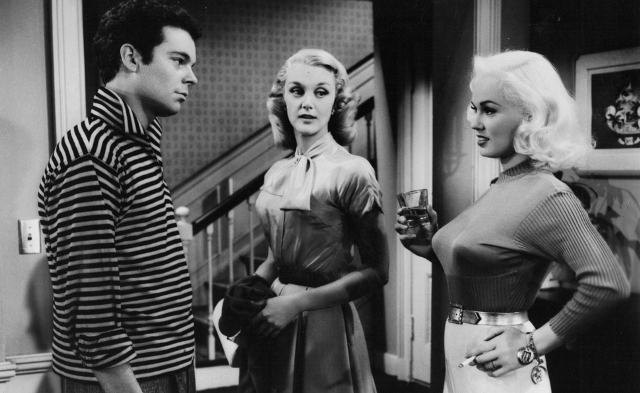
High School Confidential! 1958, a crime drama starring Mamie Van Doren, Russ Tamblyn, Jan Sterling, John Drew, Jackie Coogan, Diane Jergens and Michael Landon.
The film features a cameo by Jerry Lee Lewis who opens the movie singing the song of the same title name, which Lewis co-wrote with Ron Hargrave.
The film is listed in Golden Raspberry Award founder John Wilson's book "The Official Razzie Movie Guide" as one of The 100 Most Enjoyably Bad Movies Ever Made.
Though slammed by the critics upon release the movie was popular at the box-office and made a healthy profit.

The Space Children 1958, independently made, though released by Paramount, black-and-white science-fiction.
An alien intelligence aborts the launching of a rocket with the help of a bunch of children.
Tagline "Slowly...and with horror the parents realized THEIR CHILDREN WERE THE SLAVES OF 'THE THING' FROM OUTER SPACE!
"
The movie is not highly regarded.
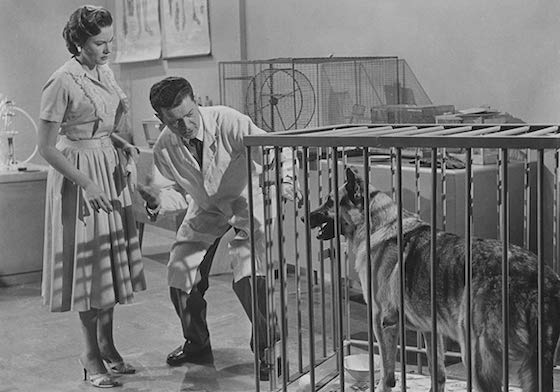
Monster on the Campus 1958, black-and-white science fiction/horror starring Arthur Franz, Joanna Cook Moore, Nancy Walters, Troy Donohue, and Whit Bissell.
Science fiction film critic Bill Warren writes that director Jack Arnold said in an interview with Cinefastastique magazine (Vol.4 No.2, 1975) that the film was shot in 12 days, and that Arnold told Photon magazine (No.26, 1975), "I didn't really hate it, but I didn't think it was up to the standards of the other films that I have done".
Critic Ken Hanke wrote that "part of the charm of this little movie is that the monster is so hokey. No, it's not classic horror, but it's a good bit of fun".

No Name on the Bullet 1959, CinemaScope Eastmancolor Western starring Audie Murphy, Charles Drake and Joan Evans.
Although it is one of Universal Pictures modestly budgeted vehicles for World War II hero Audie Murphy, the top-billed actor is unusually, but very effectively, cast as the villain, a cold-blooded gun-for-hire.
The film has come to be regarded as one of Murphy's best movies.
Film writer Jeff Stafford stated that, "unlike most of Murphy's earlier Westerns, No Name on the Bullet has a philosophical edge which makes it closer in tone to Ingmar Bergman's The Seventh Seal 1957 than a six-gun oater like Destry 1954".

The Mouse That Roared 1959, a British satirical EastmanColor comedy based on Leonard Wibberley's novel "The Mouse That Roared" from 1955. It starred Peter Sellers in three roles, and co-stared Jean Seberg and Leo McKern.
An impoverished backward micro-nation declares a war on the United States of America, hoping to lose, but things don't go according to plan.
The film was a surprise hit at the US box office.
After the 1950s, Arnold's output of cinema movies became more sporadic as he moved over to directing episodes for several television series up until 1984.

Bachelor in Paradise 1961, a romantic comedy starring Bob Hope, Lana Turner, Janis Paige, Jim Hutton and Paula Prentiss.
Bob Hope got nominated for a Golden Globe Award for Best Actor – Motion Picture Musical or Comedy.
A bachelor author of sleazy books moves to a family-oriented subdivision where he becomes an unofficial relationship advisor to unhappy local housewives, to the dismay of their respective husbands who suspect him of sexual misconduct.

A Global Affair 1964, a comedy starring Bob Hope, Michele Mercier, Yvonne De Carlo and Nehemiah Persoff.
As an employee at the United Nations building in New York City, Bob Hope finds himself in charge of an infant abandoned at the UN. Besides being a bachelor trying to cope with an infant, he must determine which nationality the baby is to have since he was abandoned on international territory. Women from several countries appear at his doorstep trying to tempt him and to get him to choose their country.
It wasn't well recieved by the critics nor at the box-office.

The Lively Set 1964, action sport drama starring James Darren, Pamela Tiffin, Doug McClure and Joanie Sommers.
The Los Angeles Times called it "the most awful little time waster".
A Chrysler Turbine Car is mentioned in the opening credit of the film. Chrysler had to participate in the film's development, since the car was the exclusive property of the corporation and its patented engine design was extensively advertised as the "engine of the future".
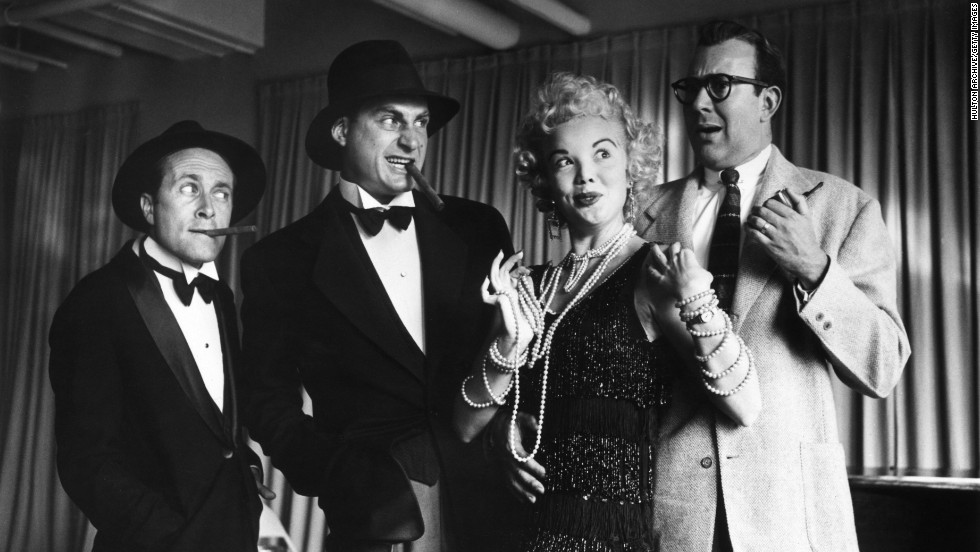
The Sid Caesar, Imogene Coca, Carl Reiner, Howard Morris Special 1967, a TV Special that earned Jack Arnold a Producer Emmy Award.

Hello Down There aka Sub-A-Dub-Dub 1969, a family oriented comedy adventure starring Tony Randall, Janet Leigh, Jim Backus, Ken Berry and Roddy McDowall.
Marine scientist Fred Miller designs the world's first underwater home, but when the business magnate funding his work threatens to end the project, Miller volunteers to live in it with his own family to prove it's practical.

Black Eye 1974, noir action blaxploation starring Fred Williamson, Rosemary Forsyth, Teresa Graves and Richard Anderson.
Private detective investigated a series of murders connected with a drug ring in Venice, California.
Dennis Schwartz of Ozus' World Movie Reviews wrote "The gritty blaxploitation crime thriller gives it a good try to be in the Chandler mode".
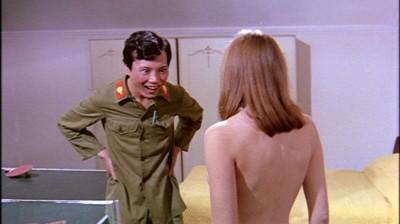
Sex Play 1974, a sex porn comedy with lots of nudity.

Boss n****r aka The Black Bounty Killer 1974, western comedy action starring Fred Williamson, D'Urville Martin, William Smith and R.G. Armstrong.
Written in 2007, Time Out suggested that Williamson was parodying the violent roles he had played in other blaxploitation films. The review noted that the movie was notable for its "old-fashioned bloodless violence".
Two black bounty hunters ride into a small town out West in pursuit of an outlaw. They discover that the town has no sheriff, and soon take over that position, much against the will of the mostly white townsfolk. They raise hell, chase women, and milk the locals for cash, while waiting for the opportunity to get their man.
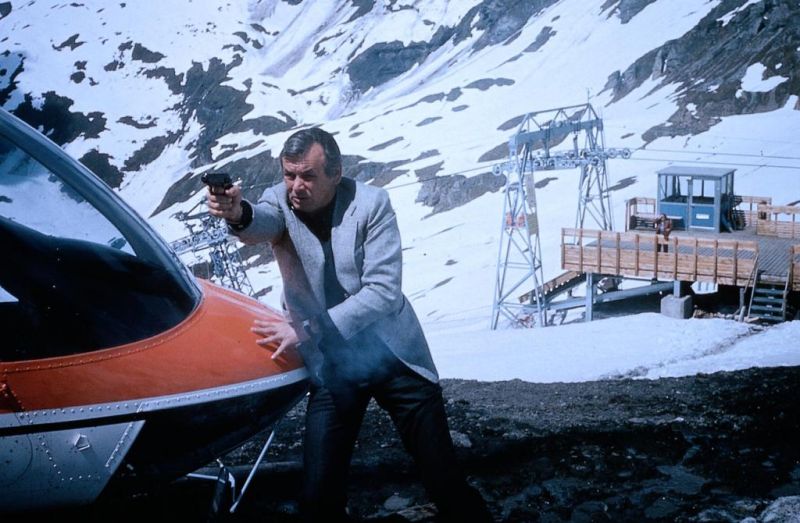
The Swiss Conspiracy 1976, action thriller starring David Janssen, Senta Berger, Elke Sommer, John Ireland, John Saxon and Ray Milland.
A former U.S. Justice Department official is hired as a security consultant for a Zurich based Swiss bank when five of its clients are blackmailed.
"Though burdened by a poor soundtrack and many obvious James Bond-esque gimmicks, the film is notable for beautiful scenery, being filmed entirely in and around Zurich. At the end of the day the scenery is the only really professional aspect of this failed attempt at entertainment".
This was sadly Jack Arnold's last movie as director.

Thanks for watching!
Thoughts, ideas, oppinions, lists, favorites and/or anything Jack Arnold are very welcome!
(The inspiration for doing this post was the OCTOBER HORROR CHALLENGE 2019 here on the IMDB v2.1)

"I love science fiction. As a youngster, I used to buy all the pulp magazines. I loved them. I was very pleased when I was assigned to direct my first SF film because I was still an avid fan. The more I did this type of film the better I liked it, because the studio left me alone. Fortunately, no one at that time at the studio was an expert at directing SF films, so I claimed to be one. I wasn't, of course, but the studio didn't know that. So they never argued with me".
Jack Arnold was born on a kitchen table in New Haven, Connecticut, to Russian immigrant parents.
As a child he read a lot of science fiction, which laid the foundations for his genre films of the 1950s.
He hoped to become a professional actor and in his late teens he enrolled in the American Academy of Dramatic Arts, where his classmates included Hume Cronyn, Betty Field and Garson Kanin.
After graduating he worked as a vaudeville dancer and in 1935 began getting roles in Broadway plays. He was acting in My Sister Eileen when the Japanese attacked Pearl Harbor, and he immediately enlisted as a cadet for pilot training.
While Arnold intended to become a pilot, a shortage of planes meant he was temporarily placed in the Signal Corps, where he took a crash course in cinematography. He then became a cameraman and learned the techniques of filmmaking by assisting Robert Flaherty on various military films.
At the war's end and Arnold's term of service ended, he formed a partnership with an air squadron buddy, Lee Goodman, to form a film production company. Their new company, called Promotional Films Company, made fundraising films for various non-profit organizations.
He also continued acting on stage during this period, in plays including a revival of The Front Page, and played opposite Bela Lugosi and Elaine Stritch in Three Indelicate Ladies.
By 1950, after his documentary films had received more exposure, he was commissioned to produce and direct With These Hands, a documentary about working conditions of the early 20th century. It was nominated for an Academy Award for Best Documentary Feature.
Arnold made his theatrical movie debut with the B picture Girls in the Night 1953. He then did his first foray into the science-fiction genre, the supreme It Came from Outer Space 1953.
Arnold's main collaborator at Universal Studios was producer William Alland.
Arnold began his television career in 1955 with several episodes of Science Fiction Theater. He went on to direct episodes for the long-running television series Perry Mason and Peter Gunn.
Arnold died of arteriosclerosis in Woodland Hills, Los Angeles, California at the age of 75. Later that year, the UCLA Film Archive held a tribute "Jack Arnold: The Incredible Thinking Man" film festival which screened a number of his films. The Archive also produced and screened a bio-documentary about his life, The Incredible Thinking Man.

With These Hands 1950, a film produced by the International Ladies Garment Workers Union, featuring several well-known Broadway actors, recreates the Triangle Fire of 1911 and compares working conditions of the 1910's with the 1950's.
Nominated for Documentary Film Oscar, Arnold's only Oscar nomination.

Girls in the Night 1953, Arnold's feature length movie debut as director. It starred Harvey Lembeck, Joyce Holden, Glenda Farrell and Leonard Freeman.
Tagline "LOOKING FOR LOVE IN THE SHADOWS".

It Came from Outer Space 1953, 3-D Science-Fiction Horror starring Richard Carlson, Barbara Rush, Charles Drake and Joe Swayer.
The first in the 3-D process from Universal-International and the first 3-D film in widescreen.
The script is based on Ray Bradbury's original story treatment and not, as sometimes claimed, a published short story, "The Meteor".
Since its original release, the critical response to the film has become positive. Bill Warren has written that "Arnold's vigorous direction and Bradbury's intriguing ideas meld to produce a genuine classic in its limited field".
Universal digitally restored It Came From Outer Space, and in October 2016 released it on Blu-ray. The film is presented in its original widescreen polarized 3-D and three-track stereophonic sound. Also a non-3-D "flat" version in mono sound.

The Glass Web 1953, a 3-D noir crime drama starring Edward G. Robinson, John Forsythe, Marcia Henderson and Kathleen Hughes, based on Max Simon Ehrlich's 1952 novel "Spin the Glass Web".
Taglines "Blonde, Beautiful...and Born to Be Murdered!" and "The Ultimate in Shocking, Suspenseful 3-D!"

Creature from the Black Lagoon 1954, a black-and-white 3-D monster horror film from Universal-International, produced by William Alland, starring Richard Carlson, Julia Adams, Richard Denning, Antonio Moreno and Whit Bissell. The Creature was played by Ben Chapman on land and by Ricou Browning underwater.
The creature, also known as the Gill-Man, is usually counted among the classic Universal Monsters.
Creature from the Black Lagoon received positive reviews from critics upon its release and is now considered a classic horror film. Leonard Maltin awarded the film three out of a possible four stars, writing, "Archetypal '50s monster movie has been copied so often that some of the edge is gone, but ... is still entertaining, with juicy atmosphere and luminous underwater photography sequences".

Revenge of the Creature 1955, was the first of two Universal-International sequels to Creature from the Black Lagoon. It was the only 3-D film released in 1955 and the only 3-D sequel to a 3-D film released during "the golden age of 3D". it starred John Agar and Lori Nelson and marked Clint Eastwood's film debut.
The critics upon release was dismissive, though it did well at the box-office.

The Man from Bitter Ridge 1955, and Eastmancolor Western starring Lex Barker, Mara Corday and Stephen McNally, based on a novel by William MacLeod Raine.
A stranger comes to the town of Tomahawk to investigate who's behind a series of stagecoach holdups.

Tarantula 1955, a black-and-white science fiction giant monster film from Universal-International, starring John Agar, Mara Corday, and Leo G. Carroll.
It was the fourth biggest film at the U.S. box-office in December 1955 and earned rentals of $1.1 million on original release.
The contemporary review in Variety indicated "A tarantula as big as a barn puts the horror into this well-made program science-fictioner, and it is quite credibly staged and played, bringing off the far-fetched premise with a maximum of believability".

Red Sundown 1956, a Technicolor Western starring Rory Calhoun, Martha Hyer and Dean Jagger.
A gunfighter takes a deputy sheriff job in a town caught in a feud between a powerful rancher and small farmers.
Tagline "Out of Texas he rode INTO THE FURY OF DURANGO'S WILDEST HOUR!".

Outside the Law 1956, a noir crime drama starring Ray Danton, Leigh Snowden and Grant Williams.
An ex-con is given the chance to redeem himself, and revenge the murder of an old army buddy, by going undercover in Germany and helping the authorities break up a ring of international counterfeiters who will stop at nothing, including murder, to protect their operation.
Tagline "T-Men Blast Counterfeiting Racket!"

The Incredible Shrinking Man 1957, Science-Fiction based on Richard Matheson's novel "The Shrinking Man" and starring Grant Williams and Randy Stuart.
When Scott Carey begins to shrink because of exposure to a combination of radiation and insecticide, medical science is powerless to help him.
The film grossed $1.43 million in the United States and Canada and was among the highest grossing science fiction films of the 1950s. A sequel, The Fantastic Little Girl, originally penned by Matheson, never went into production.
Ian Nathan of Empire referred to the film as a "classic '50s sci-fi paranoia" and noted how that the everyday objects found at home are "transformed into a terrifying vertiginous world fraught with peril. A confrontation with a ‘giant’ spider, impressively realised, as are all the effects, for its day, has become one of the iconic images of the entire era".

The Tattered Dress 1957, a Cinemascope crime noir drama starring Jeff Chandler, Jeanne Crain, Jack Carson, Gail Russell and Elaine Stewart.
The Los Angeles Times said that Chandler "does the best acting job of his career" in the film.
When top lawyer James Blane gets an acquittal for a man who killed another man for sexually roughing up his trophy wife, the murderous town sheriff frames him for bribing a juror in the case.
It did well at the box-office and Jeff Chandler was a hot property at the time.

Man in the Shadow 1957, a Cinemascope Crime Western in a contemporary setting, starring Jeff Chandler, Orson Welles, Colleen Miller and Ben Alexander.
Arnold said he had one incident with Orson Welles on Welles' first day of shooting but after that he was "wonderful" to work with and full of good ideas.
In effect, modern cow town Spurline is run by Virgil Renchler, owner of the Golden Empire Ranch. One night, two of Virgil's henchmen go a little too far and beat a "bracero" ranch hand to death. Faced with an obvious cover-up and opposition on every hand, sheriff Ben Sadler is goaded into investigating.

The Lady Takes a Flyer 1958, a romantic comedy-drama starring Lana Turner, Jeff Chandler, Richard Denning and Chuck Connors.
Husband and wife pilots Mike Dandridge and Maggie Colby try to balance their time and priorities between work and family life.
Tagline "He's got his arms around her ... all around the world !!!
"

High School Confidential! 1958, a crime drama starring Mamie Van Doren, Russ Tamblyn, Jan Sterling, John Drew, Jackie Coogan, Diane Jergens and Michael Landon.
The film features a cameo by Jerry Lee Lewis who opens the movie singing the song of the same title name, which Lewis co-wrote with Ron Hargrave.
The film is listed in Golden Raspberry Award founder John Wilson's book "The Official Razzie Movie Guide" as one of The 100 Most Enjoyably Bad Movies Ever Made.
Though slammed by the critics upon release the movie was popular at the box-office and made a healthy profit.

The Space Children 1958, independently made, though released by Paramount, black-and-white science-fiction.
An alien intelligence aborts the launching of a rocket with the help of a bunch of children.
Tagline "Slowly...and with horror the parents realized THEIR CHILDREN WERE THE SLAVES OF 'THE THING' FROM OUTER SPACE!
"
The movie is not highly regarded.

Monster on the Campus 1958, black-and-white science fiction/horror starring Arthur Franz, Joanna Cook Moore, Nancy Walters, Troy Donohue, and Whit Bissell.
Science fiction film critic Bill Warren writes that director Jack Arnold said in an interview with Cinefastastique magazine (Vol.4 No.2, 1975) that the film was shot in 12 days, and that Arnold told Photon magazine (No.26, 1975), "I didn't really hate it, but I didn't think it was up to the standards of the other films that I have done".
Critic Ken Hanke wrote that "part of the charm of this little movie is that the monster is so hokey. No, it's not classic horror, but it's a good bit of fun".

No Name on the Bullet 1959, CinemaScope Eastmancolor Western starring Audie Murphy, Charles Drake and Joan Evans.
Although it is one of Universal Pictures modestly budgeted vehicles for World War II hero Audie Murphy, the top-billed actor is unusually, but very effectively, cast as the villain, a cold-blooded gun-for-hire.
The film has come to be regarded as one of Murphy's best movies.
Film writer Jeff Stafford stated that, "unlike most of Murphy's earlier Westerns, No Name on the Bullet has a philosophical edge which makes it closer in tone to Ingmar Bergman's The Seventh Seal 1957 than a six-gun oater like Destry 1954".
The Mouse That Roared 1959, a British satirical EastmanColor comedy based on Leonard Wibberley's novel "The Mouse That Roared" from 1955. It starred Peter Sellers in three roles, and co-stared Jean Seberg and Leo McKern.
An impoverished backward micro-nation declares a war on the United States of America, hoping to lose, but things don't go according to plan.
The film was a surprise hit at the US box office.
After the 1950s, Arnold's output of cinema movies became more sporadic as he moved over to directing episodes for several television series up until 1984.

Bachelor in Paradise 1961, a romantic comedy starring Bob Hope, Lana Turner, Janis Paige, Jim Hutton and Paula Prentiss.
Bob Hope got nominated for a Golden Globe Award for Best Actor – Motion Picture Musical or Comedy.
A bachelor author of sleazy books moves to a family-oriented subdivision where he becomes an unofficial relationship advisor to unhappy local housewives, to the dismay of their respective husbands who suspect him of sexual misconduct.

A Global Affair 1964, a comedy starring Bob Hope, Michele Mercier, Yvonne De Carlo and Nehemiah Persoff.
As an employee at the United Nations building in New York City, Bob Hope finds himself in charge of an infant abandoned at the UN. Besides being a bachelor trying to cope with an infant, he must determine which nationality the baby is to have since he was abandoned on international territory. Women from several countries appear at his doorstep trying to tempt him and to get him to choose their country.
It wasn't well recieved by the critics nor at the box-office.

The Lively Set 1964, action sport drama starring James Darren, Pamela Tiffin, Doug McClure and Joanie Sommers.
The Los Angeles Times called it "the most awful little time waster".
A Chrysler Turbine Car is mentioned in the opening credit of the film. Chrysler had to participate in the film's development, since the car was the exclusive property of the corporation and its patented engine design was extensively advertised as the "engine of the future".

The Sid Caesar, Imogene Coca, Carl Reiner, Howard Morris Special 1967, a TV Special that earned Jack Arnold a Producer Emmy Award.

Hello Down There aka Sub-A-Dub-Dub 1969, a family oriented comedy adventure starring Tony Randall, Janet Leigh, Jim Backus, Ken Berry and Roddy McDowall.
Marine scientist Fred Miller designs the world's first underwater home, but when the business magnate funding his work threatens to end the project, Miller volunteers to live in it with his own family to prove it's practical.

Black Eye 1974, noir action blaxploation starring Fred Williamson, Rosemary Forsyth, Teresa Graves and Richard Anderson.
Private detective investigated a series of murders connected with a drug ring in Venice, California.
Dennis Schwartz of Ozus' World Movie Reviews wrote "The gritty blaxploitation crime thriller gives it a good try to be in the Chandler mode".

Sex Play 1974, a sex porn comedy with lots of nudity.

Boss n****r aka The Black Bounty Killer 1974, western comedy action starring Fred Williamson, D'Urville Martin, William Smith and R.G. Armstrong.
Written in 2007, Time Out suggested that Williamson was parodying the violent roles he had played in other blaxploitation films. The review noted that the movie was notable for its "old-fashioned bloodless violence".
Two black bounty hunters ride into a small town out West in pursuit of an outlaw. They discover that the town has no sheriff, and soon take over that position, much against the will of the mostly white townsfolk. They raise hell, chase women, and milk the locals for cash, while waiting for the opportunity to get their man.

The Swiss Conspiracy 1976, action thriller starring David Janssen, Senta Berger, Elke Sommer, John Ireland, John Saxon and Ray Milland.
A former U.S. Justice Department official is hired as a security consultant for a Zurich based Swiss bank when five of its clients are blackmailed.
"Though burdened by a poor soundtrack and many obvious James Bond-esque gimmicks, the film is notable for beautiful scenery, being filmed entirely in and around Zurich. At the end of the day the scenery is the only really professional aspect of this failed attempt at entertainment".
This was sadly Jack Arnold's last movie as director.

Thanks for watching!
Thoughts, ideas, oppinions, lists, favorites and/or anything Jack Arnold are very welcome!
(The inspiration for doing this post was the OCTOBER HORROR CHALLENGE 2019 here on the IMDB v2.1)



